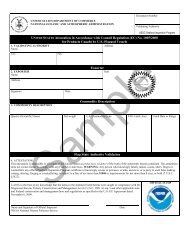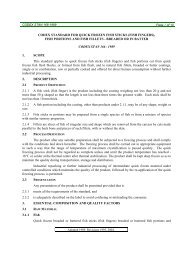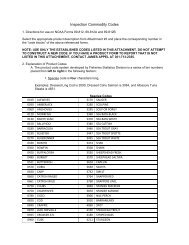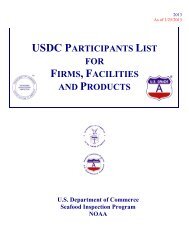Customs Labeling - Seafood Inspection Program
Customs Labeling - Seafood Inspection Program
Customs Labeling - Seafood Inspection Program
Create successful ePaper yourself
Turn your PDF publications into a flip-book with our unique Google optimized e-Paper software.
Chapter 1-United States <strong>Customs</strong> Service<br />
(3) If an article is to be sold at retail in its imported form, the purchaser at retail is the ``ultimate purchaser.''<br />
(4) If the imported article is distributed as a gift the recipient is the ``ultimate purchaser'', unless the good is a good<br />
of a NAFTA country. In that case, the purchaser of the gift is the ultimate purchaser.<br />
(e) United States. ``United States'' includes all territories and possessions of the United States, except the Virgin<br />
Islands, American Samoa, Wake Island, Midway Islands, Kingman Reef, Johnston Island, and the island of Guam.<br />
(f) <strong>Customs</strong> territory of the United States. ``<strong>Customs</strong> territory of the United States,'' as used in this chapter<br />
includes the States, the District of Columbia, and the Commonwealth of Puerto Rico.<br />
(g) Good of a NAFTA country. A ``good of a NAFTA country'' is an article for which the country of origin is<br />
Canada, Mexico or the United States as determined under the NAFTA Marking Rules.<br />
(h) NAFTA. ``NAFTA'' means the North American Free Trade Agreement entered into by the United States,<br />
Canada and Mexico on August 13, 1992.<br />
(i) NAFTA country. ``NAFTA country'' means the territory of the United States, Canada or Mexico, as defined<br />
in Annex 201.1 of the NAFTA.<br />
(j) NAFTA Marking Rules. The ``NAFTA Marking Rules'' are the rules promulgated for purposes of determining<br />
whether a good is a good of a NAFTA country.<br />
(k) Conspicuous. ``Conspicuous'' means capable of being easily seen with normal handling of the article or<br />
container.<br />
[T.D. 72-262, 37 FR 20318, Sept. 29, 1972, as amended by T.D. 94-1, 58 FR 69471, Dec. 30, 1993; T.D.<br />
95-68, 60 FR 46362, Sept. 6, 1995]<br />
§ 134.2 Additional duties.<br />
Articles not marked as required by this part shall be subject to additional duties of 10 percent of the final appraised<br />
value unless exported or destroyed under <strong>Customs</strong> supervision prior to liquidation of the entry, as provided in 19<br />
U.S.C. 1304(f). The 10 percent additional duty is assessable for failure either to mark the article (or container)<br />
to indicate the English name of the country of origin of the article or to include words or symbols required to<br />
prevent deception or mistake.<br />
[T.D. 72-262, 37 FR 20318, Sept. 29, 1972, as amended by T.D. 90-51, 55 FR 28190, July 10, 1990]<br />
§ 134.3 Delivery withheld until marked and redelivery ordered.<br />
(a) Any imported article (or its container) held in <strong>Customs</strong> custody for inspection, examination, or appraisement<br />
shall not be delivered until marked with its country of origin, or until estimated duties payable under 19 U.S.C.<br />
1304(f), or adequate security for those duties (see §134.53(a)(2)), are deposited.<br />
(b) The port director may demand redelivery to <strong>Customs</strong> custody of any article (or its container) previously<br />
released which is found to be not marked legally with its country of origin for the purpose of requiring the article<br />
3<br />
Attachment #1<br />
(May 1985)






